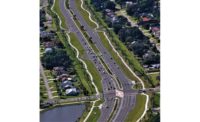ENR Mountain States Best Projects 2019
Best Highway/Bridge: Bangerter Four Interchanges Design-Build

Bangerter Four Interchanges Design-Build
PHOTOS COURTESY MICHAEL BAKER INTERNATIONAL

Bangerter Four Interchanges Design-Build


Bangerter Four Interchanges Design-Build
Layton, Utah
Best Project
Owner: Utah Dept. of Transportation, Region 2
Lead Design Firm & Structural, Civil Engineer: Michael Baker International
General Contractor: RLW/Clyde, a Joint Venture (Ralph L. Wadsworth Construction Co. LLC and W.W. Clyde & Co.)
Consultant: H.W. Lochner
Subcontractors: Boulderscape; DDI Inc.; Dry Creek Structures; Gateway; Geneva Rock Products; Harper Concrete; Mammoth; Ralph Smith; RBI; RC Hunt; Wagstaff Crane; Wheeler Machinery
The Bangerter Highway is a major north-south artery serving Salt Lake County that also provides access to Salt Lake City International Airport. It is called a “partial expressway” because it has several at-grade, signalized intersections, including one that handles nearly 94,000 vehicles daily.
The Utah Dept. of Transportation sought to remove bottlenecks at four of the highway’s most heavily trafficked intersections—7000 South, 9000 South, 11400 South and 5400 South—and replace them with grade-separated interchanges. That included raising the highway above grade at three intersections and bringing the fourth one below grade.
The goal was to finish major construction before the next holiday shopping season, a vital concern for venues along the highway.
To minimize disruption on this design-build project, the joint venture contracting team worked with Michael Baker International to create sub-units that allowed concurrent design and development of the interchanges. The on-site colocation of designer, builder and owner helped to ensure that the right decisions were made promptly, keeping the fast-track project on schedule.
One of the key challenges was mitigating excessive vibration, loading and settlement along the right-of-way during construction. The issue came up because a 1970s-era aqueduct owned by the U.S. Bureau of Reclamation and operated by the Jordan Valley Water Conservancy District lacked joint restraints. The aqueduct traverses nearly the entire length of the project, with 78-in. pipe at two of the interchanges and 66-in. pipe at the others. The team developed a plan that coordinated more than 20 permits for encroachment in the easement and permitting to allow for early rough grading.
Crews also installed a custom foundation for sign and signal equipment in the easement along with drainage systems to limit the number of pipes and catch basins.
The team maintained three lanes of traffic in each direction for nearly the entire project, reaching substantial completion in November 2018 after working 289,758 hours with no lost-time accidents. The new interchanges have reduced average travel time on the highway by nearly 15 minutes.
Back to "Annual Awards Competition Attracts the Most Entries in Its History"





